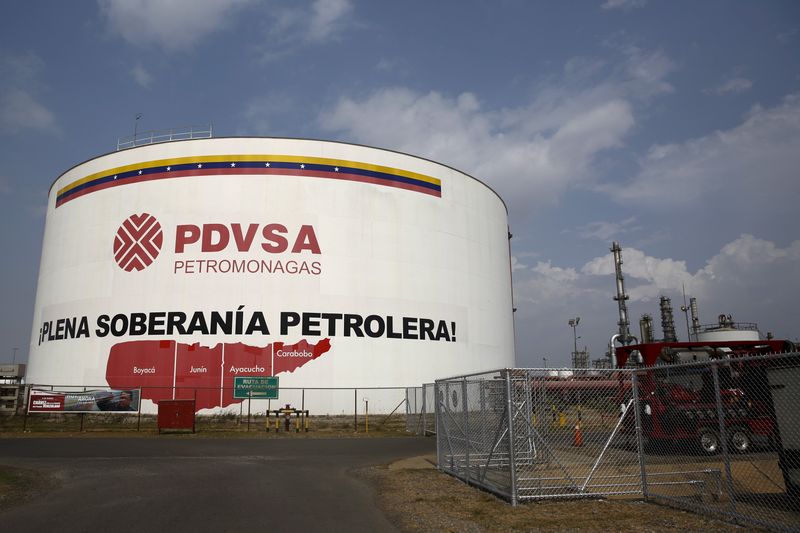By Luc Cohen, Mircely Guanipa and Marianna Parraga
(Reuters) - Venezuela's state-run oil company Petroleos de Venezuela has cut crude production at several locations and its main crude blending plant has been operating intermittently this month due to mounting stockpiles, according to a half-dozen industry sources and documents seen by Reuters.
Venezuela's oil industry has been squeezed by more than a year of sanctions from the United States, and in recent months the Trump administration has increased the pressure on some of the remaining buyers of Venezuelan crude. Washington sanctioned PDVSA early last year as part of the administration's efforts to oust President Nicolas Maduro.
That has caused exports to fall sharply, boosting domestic crude storage to a total of 38.2 million barrels, up 2.3 million barrels from the end of April, according to market intelligence firm Kpler. In September 2019, inventories reached 40.3 million barrels, but drained as exports picked up.
Overall, Venezuela produced 656,000 barrels on May 13 and 642,000 barrels on May 14, according to the most recent internal PDVSA data seen by Reuters. That was down from the 737,000 barrels per day the country told OPEC it produced on average in April.
At the Jose export terminal, inventories of Merey crude - Venezuela's signature export blend - rose this week to 9.6 million barrels, up from 7.2 million barrels on May 4, reducing available space to just 318,000 barrels, according to PDVSA documents seen by Reuters.
The dearth of storage prompted PDVSA on Sunday to halt operations at the Petrosinovensa blending facility, a joint venture with China's CNPC (CNPC.UL) that converts extra-heavy crude from the Orinoco belt into Merey, according to the document. It resumed operations again on May 25.
The plant had stopped in mid-May for several days due to high inventories, according to another PDVSA document. The facility produced around 100,000 bpd between May 20 and May 24.
The Petropiar crude upgrader, part of a joint venture between PDVSA and Chevron Corp (N:CVX), is the only one of five upgrading and blending plants that continues to operate, processing some 120,000 bpd of extra-heavy oil to produce Hamaca crude, according to the document. It is also faced with dwindling storage capacity.
Exports have declined from last year, as Russia's Rosneft (MM:ROSN), the largest intermediary of Venezuelan crude last year, stopped purchasing PDVSA's oil after the U.S. sanctioned two of its trading units in February and March. Washington is also probing other major PDVSA customers for possible sanctions violations.
Neither PDVSA, Venezuela's oil ministry nor CNPC immediately responded to requests for comment. Chevron deferred comment to PDVSA.
With inventories rising, PDVSA has been forced to reduce production of extra-heavy crude in the Orinoco belt. The upstream portion of Petropiar, which was Venezuela's most productive project in March at some 123,000 bpd of output according to an internal PDVSA document, is now producing at around half those levels, two people familiar with the matter said.
The Petromonagas project, which produced some 75,000 bpd in March, according to the document, also substantially cut output in recent weeks, one of the people said, although current production levels were not available.
In the country's western areas near Maracaibo Lake, the Petroboscan joint venture between PDVSA and Chevron halted output this month, according to four people with knowledge of the matter. Separately, the Petrozamora joint venture between PDVSA and GPB Global Resources only produced around 30,000 bpd on May 23, compared with 66,000 bpd in March.

Together, the two western joint ventures produced nearly 150,000 bpd in March.